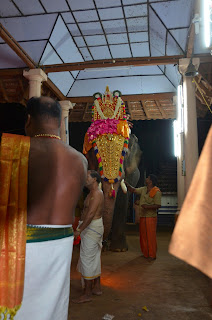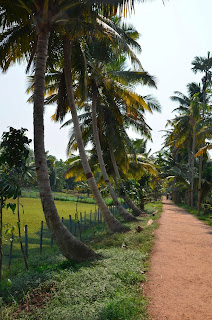For Spring Break we ventured South to Kerala, a state nestled on the southwest coast of India that is known as "God's own Country" because of its splendid natural beauty. Kerala is blessed with a very scenic chain of lagoons and lakes that lie parallel to the Arabian Sea Coast (the backwaters), amazing wild life, and a culture completely unique to this region. The people, known as "Keralites", are very simple and kind people who speak a language called Malayalam. Agriculture is the mainstay of the economy.
Once we arrived we immediately noticed how the state felt quite different from any other we have visited in India, presumably due to the communist rule. We were struck by it's cleanliness, safety and educated population. The state boasts 100% literacy and 100% employment as everyone is guaranteed an education, proper healthcare and nutrition. As a result Kerala has the lowest infant mortality and the highest life expectancy in India. Everyone is pretty equal here so those Keralites who want a higher standing of living migrate to places like Dubai.
Our first stop was Trivandrum, the capital of Kerala. The city is one of the oldest in India and was a famous port during 1050 BC when it had trade relations with many Middle Eastern and Mediterranean countries. Today Trivandrum is one of the primary commercial and industrial areas of Kerala. The city is characterized by its undulating terrain of low coastal hills and busy commercial alleys.
On our drive from the airport I was struck by the many fishing villages we passed by. At this time of day the fisherman had all come in from their work at sea and were relaxing with their peers.
Some other scenic views from our drive to our hotel.
We stayed at a charming seaside resort in Kovalam, just 12 km from the airport. This was the view from our hotel.
The vaults were only opened for the first time in 2011 by a committee set up by India's supreme Court in the course of hearing a case about who should manage the temple, presently run by members of the formal royal family of the area. The precious diamonds, gold, emeralds, rubies, antique silver, brass and gold idols found in the vault are estimated at $22 billion.
Only five of the six underground chambers has been opened, and temple officials say the sixth will not be open, citing "ancient legends of a bad omen befalling the state as well as those involved in the exercise". Who knows how much more wealth is stored in this chamber!
The gold encrusted temple is shown below. The temple attracts millions of visitors each year. Only Hindus in full traditional dress are allowed in to the temple.
The street leading to the temple was adorned with these big idols of Pandavas, characters in the Hindu epic Mahabharata.
From the temple we ventured to Napier Museum, an art and natural history museum that displays a vast collection of prized stone sculptures, wood and ivory carvings and handicrafts. The ancient sculptures and artifacts of this museum are a major draw for visitors.
The next day we drove to Kumarakom, which was about a three hour drive. Our hotel was beautifully set on a lagoon, which our charming cottage faced. The setting of the resort was so serene and beautiful. The kids especially loved riding bikes around the property - something they terribly missed by living in Delhi. There were a number of other kids staying at the resort, a number of whom were classmates at the American school in Delhi.
This Victorian two storied bungalow shown below was the main dining hall for the hotel. It was built by British missionary Alfred George Baker in 1881 on huge pieces of Teak wood rafters packed in mud as a base. It was the house of four generations of the Baker family, for over a hundred years, before Taj hotels restored it. This bungalow, called the "History House" is the setting for Arundhati Roy's "The God of Small Things"
That evening we attended an annual South Indian temple festival. This festival was a tribute to the temple's presiding God, Lord Shiva, who emerges from inside the temple only once a year. This elaborate festival featured a large procession of bejeweled elephants, drummers and other musicians.
This elephant is carrying a statue of Lord Shiva. Over the next several days this elephant will visit every home in the area to bless everyone individually. It is the only time of the year that God leaves the temple and visits people's homes.
Here the elephant is descending the long staircase and is being welcomed by the masses.
This festival was quite an experience for us, as it is unique to Hindu devotees in the South.
The next morning we started our day by visiting the Kuramakom Bird Sanctuary on the banks of Bembanand Lake. It was a great opportunity to watch all kinds of bird life up close.
We roamed away from the sanctuary and saw nature at its best.
Jack fruit!
Later that afternoon we boarded a houseboat to cruise the famed backwaters of Vembanad Lake. This was a true highlight of this trip. On the cruise we were treated to an unbelievable beautiful paradise of mangrove forests, emerald green paddy fields and coconut groves interspersed with enchanting waterways and canals. Traveling by houseboat was pure relaxation!
This was our houseboat.
Once we got to the heart of the scenic lake we came across plenty of traditional country crafts, boats and canoes. The backwaters houses a variety of species of both fauna and flora so there are plenty of fisherman looking for the catch of the day!
Tons of coconut palm trees lined the rivers.
A fisherman's home.
We walked inland to see a fishing village.
Holi got its name as the "Festival of Colors" from Lord Krishna, a reincarnation of Lord Vishnu, who liked to play pranks on the village girls by drenching them in water and colors.
The kids had such a blast celebrating Holi!
The next morning we left for Kochi, a two hour drive from Kumarakom. Kochi is a major port city on India's western coast and is also the state's most densely populated city.
Kochi was the centre of the Indian spice trade for many centuries. It's spices were exported to the Greeks, Romans, Jews, Arabs and Chinese since ancient times.
Our first stop was Jew Town. The Jews first came to the Kochi area as early as 700 B.C. because of trade. Jews eventually became so plentiful in the area that the Hindu Raja granted them a seat for their own town, called "Jew Town" right next to Kochi. Although many Jews flocked to Israel or were converted to Christianity, many Jews are still in the area. The main attraction in "Jew Town" is a very old synagogue, which is still revered by Jews from all over the world.
Unfortunately we were not able to visit the synagogue because it was Passover.
Shailen with some cinnamon from the spice market.
Jew Town is still the centre of the Spice Market. The exotic odor of the finest ginger, cloves, cardamom, turmeric and pepper emanate from the spice warehouses lining the streets of Jew Town.
Then we walked to the Harbour to see the Chinese fishing nets.
The Fort Kochi street market showcase bursts of colors - clothes, bags, jewelry, and these pretty dolls.
The real draw to the Harbor are the Chinese fishing nets, shown below in the background. They operate on principles of Physics advanced for their time when they were developed in ancient times. Presently these types of fishing nets are mostly found in Kerala.
The fish nets are huge mechanical contrivances which hold out horizontal nets of 20m or more across. Each structure is at least 10 m hight and comprises a cantilever with an outstretched net suspended over the sea. On the other end large stones suspended from ropes act as counterweights. The system is sufficiently balanced that the weight of a man walking along the main beam is sufficient to cause the net to descend in to the sea. The net is left for a short time, possibly just a few minutes, before it is raised by pulling on ropes. Although the catch is usually modest, it is usually sold to a passerby within minutes.
Here a fisherman is selling his fresh catch, presumably from the Chinese fishing nets.
Next we ventured off to St. Francis Church, the oldest European built church in India. The Portuguese constructed it in 1503.
The famous Vasco Da Gama, the first European to reach India by sailing around Africa, was buried in Kochi for 14 years after his death in 1524 and was later transferred to Lisbon. His tombstone is inside the church.
Vasco De Gama's tombstone, now empty, is just inside this window.
Nearby is Santa Cruz Cathedral. It was originally built by the Portuguese and elevated to a cathedral by Pope Paul IV in 1558. Some beautiful paintings can be seen here.
We loved the colorful homes in the area.
Next we visited a washing village in town, called Dhobi Khana. Washing establishments like this one were established during British rule when officers brought in villagers to do their laundry. The men usually do the washing, while their wives join them to dry and iron the clothes.
As we drove back to our hotel I captured the colorful boats that were docked.
That evening we went to a cultural show featuring Kathakali Dance, one of the most popular dance forms in Kerala. The genre of dance is termed dance drama. Kathakali involves the presentation of a drama through the expression of dance. The performances are accompanied by instrumental as well as vocal aids. The basic expressions of the dance form are delivered by the hands. The expressions suggested by the subtle hand movements are complimented by the movements of the face, particularly the eyes.
The next morning we visited the Mattacncherry Palace, also known as the Dutch Palace, as the Dutch did substantial renovations to it. The Portuguese built this palace in 1557. The palace is knows for its famous murals that depict the various scenes of the Ramayan, Mahabharta and legends of Hindu gods. It has since been converted to a museum.
The Grounds of the Palace were so beautiful; we waited an hour for the museum to open so we had plenty of time to enjoy it. The flowers were in full bloom.
Priya loved the small zoo on the grounds. She was a magnet to the spotted deer.
This ended our amazing week in Kerala. We are so glad that we had the chance to visit this beautiful coastal state with so much natural beauty, culture and history.




































































































No comments:
Post a Comment